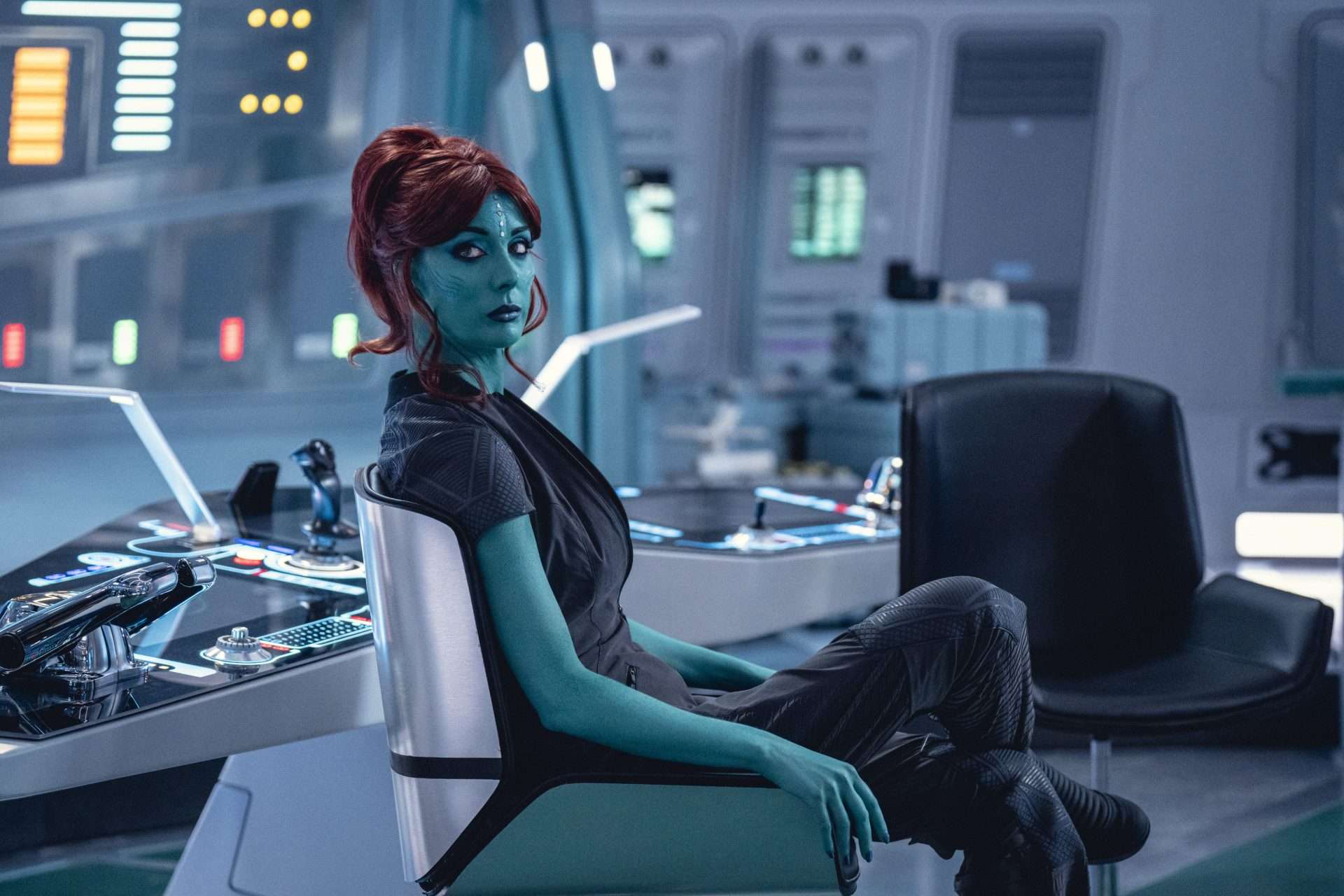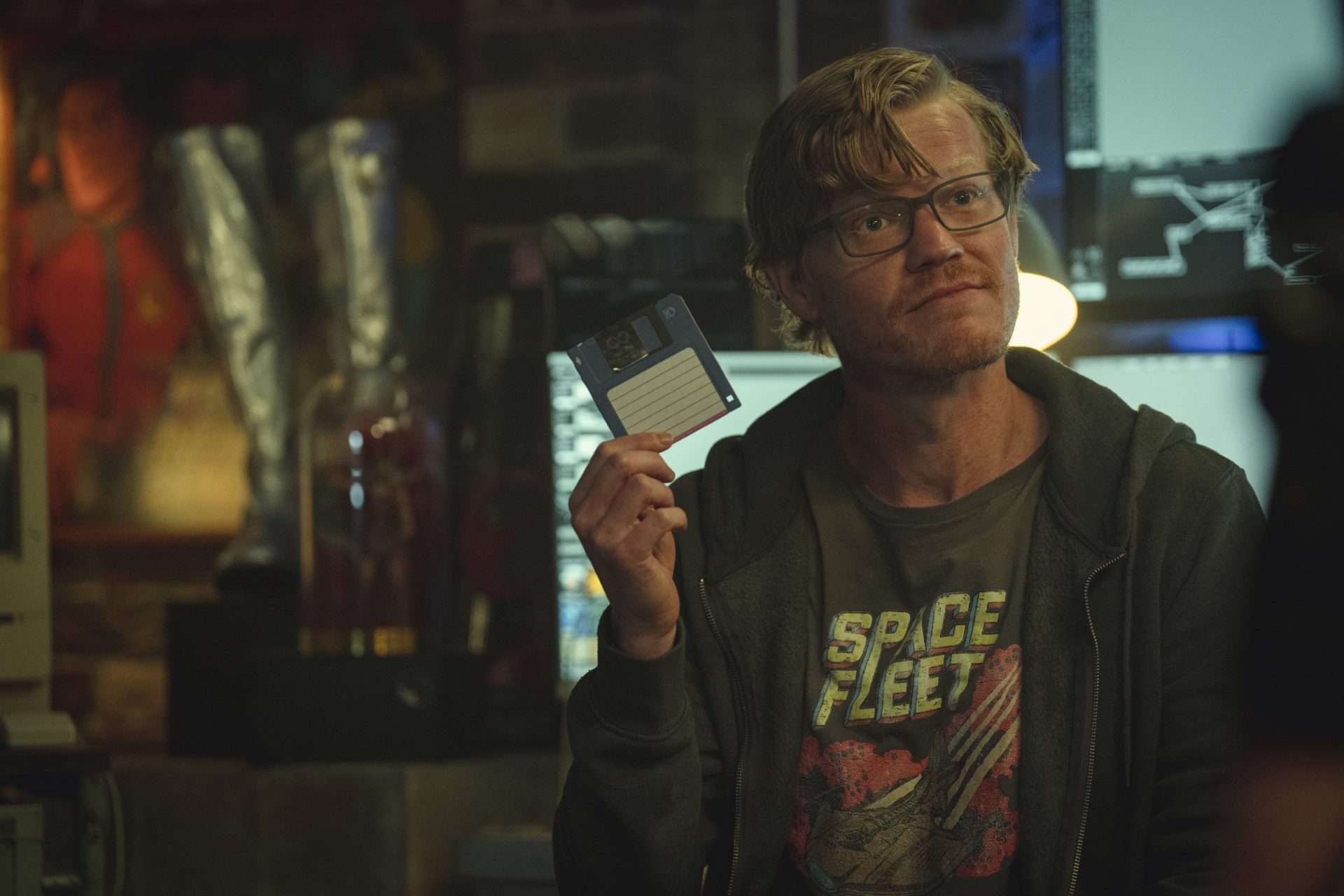The final episode of “Black Mirror” (Season 7), Episode 6, “USS Callister – Into Infinity”, doesn’t just cap off a new installment—it closes a loop that first opened in Season 4’s premiere. Directed by Toby Haynes, “USS Callister” (2017) was everything commercial American sci-fi usually reduces itself to: CGI-soaked mythmaking padded with faux sentimentality and self-aware humour designed to sedate rather than provoke. But beneath that plasticky surface, it was also sneakily subversive—where indulgence became texture, and the mess was alive with greasy narrative bravado. At its core lay a searing takedown of unchecked, geek-coded power.
This sequel picks up right where the original left off and stretches that myth outward and inward. The visuals are bolder, the stakes heavier, and the monsters are more psychological than programmed. But Haynes doesn’t just scale it up for scale’s sake. He shapes narrative momentum around Nanette Cole (Cristin Milioti, effortlessly electric), treating her arc not as an add-on but a continuation that deepens what’s already there. The multiverse angle feels less like a studio mandate and more like an emotional logic—the natural language of a fractured spaceship crew grappling with post-villain existential drift.
The humour remains wicked and cheeky, but it’s tinged now with a shade of resignation. That resignation becomes part of the joke—and makes it land harder. It plays like an elegy disguised as a popcorn gag. And then there’s the meta-cinema of it all. The first film was made in an age drunk on Marvel worship, where sameness was confused with consistency. The world hasn’t evolved much, but at least it’s sobered up a bit. This sequel drops the former’s rage and opts instead for a wry acceptance of the medium’s mainstream grammar—identity politics, legacy sequels, even an “Inside Out” homage retextured as body horror.
It’s all deeply entertaining, yes, but not something that yields itself in a single watch. There’s grease under this engine. So here’s our attempt at cracking it open—layer by layer.
Black Mirror (Season 7), Episode 6, “USS Callister – Into Infinity” Recap
What happens after Daly’s death inside the game?
The story picks up exactly where it left off—Robert Daly is dead, both in real life and inside his personal, deleted universe. With Daly gone, Nanette Cole now captains the USS Callister, but her dreams remain haunted by the horrors and control he once exercised. Alongside her fellow clones—Kabir, Nate, Elena, and Karl—Nanette struggles to survive the hostile terrain of the Infinity game.
They enter a bleak, icy plateau, where they ambush and kill three new players, managing to snatch a player tag in the process. During the skirmish, Nanette gets injured. Blood seeps from her chest, shocking the opposing player because Infinity, for all its hyper-realistic immersion, is famously bloodless. Despite the risk, the crew walks away with only thirty-four credits—barely enough to survive a few more days.
Why is Robert Daly’s presence still felt in the real world?
In the real world, Nanette logs out and heads to work. At the office, she grows uneasy at the sight of Robert’s photo framed with memorial candles on the manager’s desk. She asks Elena why it’s still there, months after Daly’s death. Elena explains Walton kept it to impress a visiting journalist. Meanwhile, Kabir tries to alert Walton to a growing issue: New players are filing complaints about mysterious, bleeding robbers looting player tags. Walton, chalking it up to some freeloader bug, waves it off. But the problem resurfaces when the New York journalist questions him about a rumored cloning box that used to sit on Daly’s desk. Uncomfortable and pissed off, Walton kicks the journalist out.
Afterward, he storms over to Kabir, asking him to dig deeper into the bug. But Kabir’s already out—he’s quit. Back in the game, Nanette and Nate are on another heist, targeting a player named Pixie Bumpkin who seems loaded with credits. Just as they move in, a mysterious spaceship ambushes their vessel.
How does Nanette discover the truth about her in-game clone?

Real-world Nanette decides to investigate on her own. She accesses Kabir’s complaint logs and scrolls through until she finds gameplay footage—footage of herself and Nate robbing the player. Shocked, she approaches Walton and confesses that the in-game robbers are her and Nate. She explains how Daly used employees’ DNA—including hers—to create clones within the game. As proof, she reveals she was at Daly’s apartment the night he died. She also shows Walton the DNA collection Daly had gathered, including samples of Walton and his son.
Inside Infinity, the crew is unraveling. They’re desperate, cornered by a game world that seems stacked against them. Nanette proposes a bold plan: hack the source code by gaining access to the core engine, aptly named the Heart of Infinity. But to pull it off, they need Walton’s help. He’s the only one still alive in the real world and—bizarrely—the only character whose atoms were somehow re-cloned and preserved inside the game. With Kabir’s help, they trace the game version of Walton to a remote planet. Nanette visits and finds him living like a deranged, half-naked caveman. Luckily, he still has his wits.
What happens when real-world Nanette and Walton enter the game?
Meanwhile, the real Nanette and Walton break into Daly’s old computer and enter the game. They’re stunned to meet their in-game selves. Nanette, especially, is floored by how capable and fierce her digital version is. They board the ship, but Walton, overwhelmed by the surrealism, loses his shit. He grabs a blaster and starts shooting the clones, hell-bent on wiping them out and ending the madness. He succeeds in killing Karl, but Nate manages to overpower him. Nanette wakes up in real life, furious, and kicks Walton—literally and metaphorically—for his monstrous behavior. She refuses to help him further and storms off, only to get into a car crash during the argument. Walton steals the gameplay chip from her.
Also Read: Black Mirror (Season 4) Episode 1, USS Callister: Ending Explained, Themes & Symbols Analyzed: Did Daly Learn His Lesson?
Black Mirror (Season 7), Episode 6, “USS Callister – Into Infinity” Ending Explained:
How does Nanette fight back against Daly’s clone in the Heart of Infinity?
Back in Infinity, clone Nanette tries to reach her real-world counterpart, only to discover she’s in a coma. Walton reappears and delivers a truth bomb: he met Daly twelve years ago, when Daly was just another Space Fleet tech nerd. Obsessed with Daly’s game, Walton begged him to build fifty more universes. Daly refused, saying he could barely manage one. So, Walton took matters into his own hands. He created the Heart of Infinity, enslaving a clone of young Daly and forcing him to code endlessly, generating new universes. This, it turns out, is the dark origin of Infinity—a game empire built on illegal genetic cloning. The same tech that got banned when people started making clones for cybersexual abuse.
Nanette, disgusted and determined, commands the crew to head straight to the Heart. She wants to meet this clone. And when she does, she’s surprised—he’s kinder, more naive, more… human than she expected. But peace doesn’t last. Real Walton, now back in the game, pulls a dick move: he invites every player Nanette’s crew has robbed. In her absence, they chase down the ship, forcing the crew into a full-blown escape mission.
In the Heart, Daly’s clone confides in Nanette: he knows how to transfer her consciousness into her real body and place her crewmates into a pocket dimension. But he wants something in return: companionship. He’s been painfully alone for years. Nanette refuses. The rejection triggers Daly’s buried misogyny. His inner Robert returns with a vengeance. What follows is pure horror. He seals her mouth telepathically, throws her around with mind control, and declares he’ll enslave her to soothe his loneliness. But Nanette fights back. She grabs a Space Fleet axe and drives it straight into his head. Daly dies. And with him, the Heart collapses.
What happens to the crew and the future of Infinity?
As the game disintegrates, Nanette scrambles to find the disk containing Daly’s salvation protocol. She slams it into his console and beats it until it boots. At last, her consciousness is transferred into her real body. The clones aren’t deleted—they’re now part of her mind. The USS Callister crew believes they’re in a pocket dimension. But in reality, they now live inside Nanette’s brain—a fused consciousness of game-self and real-self. They don’t control her; they spectate her life like it’s TV.
As Infinity collapses, Walton’s crimes are exposed. After three months on the run, he’s arrested. Nanette sets boundaries in her new life-body: the crew agrees to close their eyes when she showers or has sex. In return, she lets them indulge their guilty pleasure—binge-watching that cursed “Real Housewives of Atlanta” reality show.
Black Mirror (Season 7,) Episode 6, “USS Callister – Into Infinity” Themes Analyzed:
Digital Afterlives and Consciousness Ethics

Over the years, “Black Mirror” has consistently obsessed over cloning minds and trapping them in digital prisons. And honestly, it’s such a potent mix of sci-fi intrigue and ethical unease that it keeps landing with fresh resonance. “USS Callister: Into the Infinity” follows that legacy—this time expanding the idea of sentient digital clones who aren’t just conscious but evolving, suffering and even forming identities far beyond human oversight.
While the humans remain blissfully unaware, their clones bear the emotional weight of their creators’ real-world neuroses. The film also dives deep into the sticky grey zone of who owns that consciousness—if it’s your clone, is it still you? And who decides its fate? For the humans—arrogant, oblivious, self-absorbed—like Walton, it’s not even a question. Of course, they think it’s them.
But the clone of Nanette complicates that. Assertive and defiant, she comes face to face with her real-world self—meek, self-doubting, terrified. There’s something gently radical in that moment of acceptance. Nanette doesn’t erase her clone. She integrates it. It’s healing not by rejection of fracture but through a kind of fusion. Daly’s clone, once the oppressor, is now a victim of the same system, revealing how even the most entitled behaviors can be inherited, shaped, and weaponized. There’s something deeply human about how the film wrestles with all this. It is political in its dismantling of digital identity.
Tech Bros, Ego Empires, and the Illusion of Control
It was Daly the first time. This time, it’s Walton. Between the two, USS Callister skewers the same archetype from two angles: the toxic visionary who builds fiefdoms under the guise of brilliance. The film wastes no time in laying it bare: Walton, despite his media-polished humility, is a hollow shell. He mourns Daly with PR-smoothed theatrics while not even remembering the name of his unpaid intern of 18 months.
This is classic tech-bro theater. Innovation becomes exploitation. Brilliance becomes branding. What starts as code ends up a kingdom, rigged, controlled, and emotionally blackmailed into obedience. Heart of Infinity is the perfect metaphor for Silicon Valley—vast, glossy, ever-expanding, and soulless. Designed to dazzle, but when you peer into its depths, all you see is a void. It’s talent-fed but creativity-starved, a system that doesn’t reward genius so much as it uses it to inflate the next big thing. Even the game’s players—like Pixie Bumpkin—become casualties, stuck in a loop of violence and objectification while the emperors play God.
Fragmented Womanhood and the Politics of Self-Integration
The arc of Nanette—both real and digital—is less about escape and more about integration. Unlike classic redemption arcs or feminist revenge tropes, the film doesn’t offer a single triumphant arc. It gives us a fractured, conflicted one. Here’s a woman who exists in multiple selves: the one who doubts, the one who fights, the one who performs strength because she has no choice. She’s not trying to become whole by erasing her cracks; she embraces them.
Her decision to fuse with her digital clone is, in many ways, the emotional centerpiece of the film. It’s not just sci-fi fantasy; it’s a radical choice to own one’s fragmented identities rather than live under the illusion of a singular, stable self. In a techscape dominated by male-coded control and projection, Nanette reclaims her agency not by escaping the simulation but by transforming it, turning the tools of surveillance into platforms of solidarity.
The clone crew’s promise to “watch her life respectfully” is more than a punchline. It’s a quiet nod to the complexities of female autonomy in systems built for voyeurism. What happens when a woman is not just seen, but truly seen, by her selves, by others? The film offers no neat answer, just a startlingly honest one.



![The Adam Project [2022] ‘Netflix’ Review: Ryan Reynolds-led Time Travel Movie Shines When It Wants to Be Heartfelt](https://79468c92.delivery.rocketcdn.me/wp-content/uploads/2022/03/The-Adam-Project-768x384.jpg)



